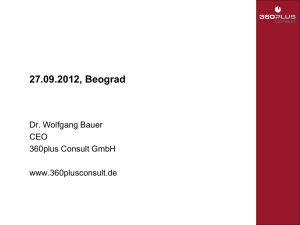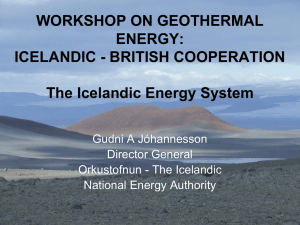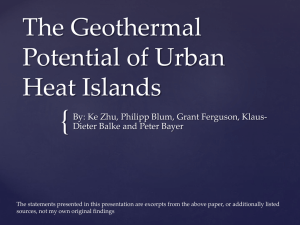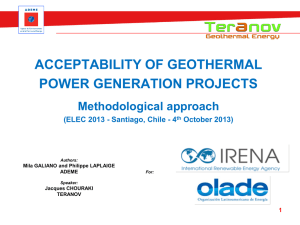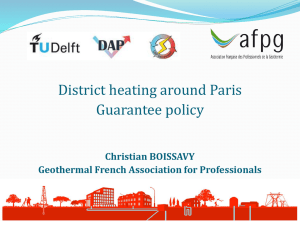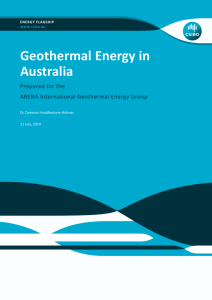The Business Case for Geothermal Energy
advertisement
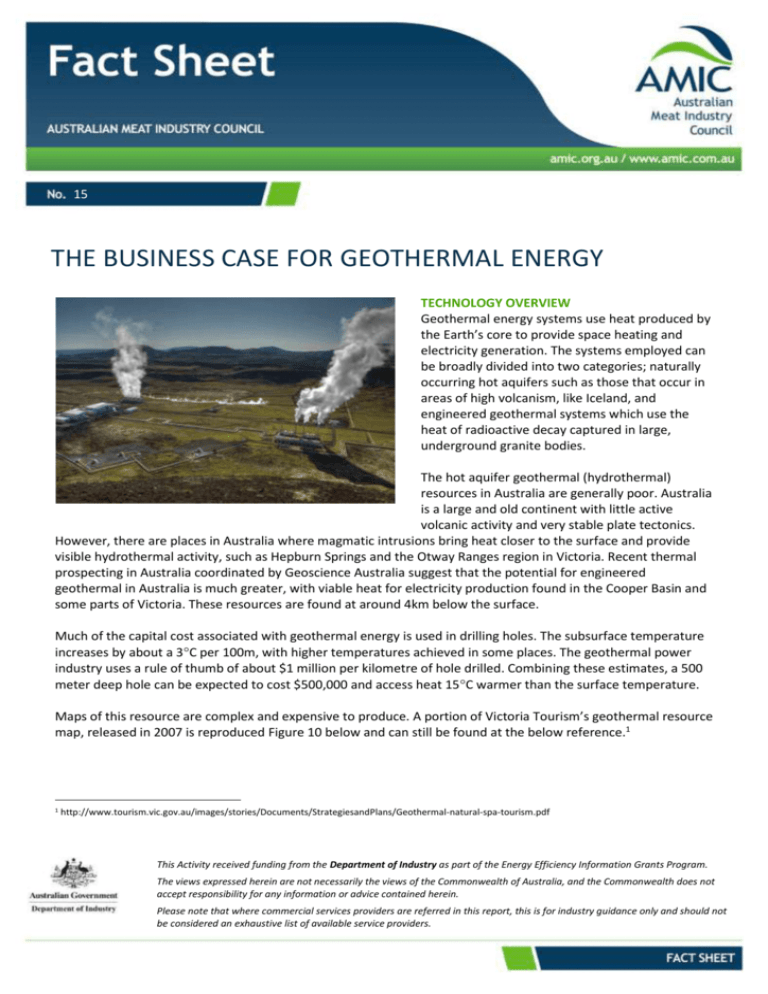
15 THE BUSINESS CASE FOR GEOTHERMAL ENERGY TECHNOLOGY OVERVIEW Geothermal energy systems use heat produced by the Earth’s core to provide space heating and electricity generation. The systems employed can be broadly divided into two categories; naturally occurring hot aquifers such as those that occur in areas of high volcanism, like Iceland, and engineered geothermal systems which use the heat of radioactive decay captured in large, underground granite bodies. The hot aquifer geothermal (hydrothermal) resources in Australia are generally poor. Australia is a large and old continent with little active volcanic activity and very stable plate tectonics. However, there are places in Australia where magmatic intrusions bring heat closer to the surface and provide visible hydrothermal activity, such as Hepburn Springs and the Otway Ranges region in Victoria. Recent thermal prospecting in Australia coordinated by Geoscience Australia suggest that the potential for engineered geothermal in Australia is much greater, with viable heat for electricity production found in the Cooper Basin and some parts of Victoria. These resources are found at around 4km below the surface. Much of the capital cost associated with geothermal energy is used in drilling holes. The subsurface temperature increases by about a 3C per 100m, with higher temperatures achieved in some places. The geothermal power industry uses a rule of thumb of about $1 million per kilometre of hole drilled. Combining these estimates, a 500 meter deep hole can be expected to cost $500,000 and access heat 15C warmer than the surface temperature. Maps of this resource are complex and expensive to produce. A portion of Victoria Tourism’s geothermal resource map, released in 2007 is reproduced Figure 10 below and can still be found at the below reference.1 1 http://www.tourism.vic.gov.au/images/stories/Documents/StrategiesandPlans/Geothermal-natural-spa-tourism.pdf This Activity received funding from the Department of Industry as part of the Energy Efficiency Information Grants Program. The views expressed herein are not necessarily the views of the Commonwealth of Australia, and the Commonwealth does not accept responsibility for any information or advice contained herein. Please note that where commercial services providers are referred in this report, this is for industry guidance only and should not be considered an exhaustive list of available service providers. Figure 1: Geothermal resource map created by Tourism Victoria Geoscience Australia have also mapped the geothermal resource, but as this was intended for the power industry, it maps the resource at a level far deeper with the higher temperatures needed for power generation.2 IS IT SUITABLE FOR YOUR MEAT PROCESSING FACILITY? Except in cases where the geothermal resource essentially occurs at the surface (which is the case in areas of active volcanism such as Iceland, New Zealand and Japan) this technology requires the drilling of multiple boreholes and is very expensive. The costs associated with deep drilling required for electricity production make it prohibitive as site electricity supply. In cases where there is a shallow source of hot water, there is potential to use the water for general purposes such as hand cleaning or a pre-heated feed to a boiler or hot water system. This is especially useful if the water is extracted for other purposes such as a fresh water supply. As the drilling cost is high and effectively fixed, the viability of geothermal projects is based on the cost of energy which it offsets, and any co-benefits, like water access, which come with the project. A hybrid geothermal/cogeneration system was installed at Midfield International in Warrnumbul, Victoria.3 This is the only known installation is this type in the Australian red meat processing industry. HOW TO DEVELOP YOUR BUSINESS CASE The actions to take when developing a business case for a geothermal energy project include: Determine your heat load Determine your geothermal resource potential Consider the future cost and risks of your current heat supply DETERMINING YOUR HEAT LOAD How much heat do you need daily, annually? Unlike electricity, there is no market for businesses to sell heat into. However, there may be opportunities to partner with other businesses in your area which have significant heat loads as well. Also consider too what you could do if you had access to low cost heat. Much of the cost in a 2 3 http://www.ga.gov.au/image_cache/GA10036.pdf http://www.ampc.com.au/site/assets/media/Factsheets/Climate-Change-Environment-Water-Waste-Energy-Sustainability/11-AMPC-MLACogen-Geothermal-Midfield-Group.pdf geothermal project is the fixed cost of drilling, so the marginal increase of delivering extra heat is small. This heat could be used to meet future requirements created by expansion in processing capacity. DETERMINE YOUR GEOTHERMAL RESOURCE POTENTIAL Establish how much potential there is for geothermal energy in your area. A good indicator of a geothermal resource is the presence of hot springs, as on the Mornington Peninsula in Victoria. Beyond this, there are resource maps available through state and federal agencies such as Tourism Victoria and Geoscience Australia. At the completion of this stage you should have an idea of the temperature gradient in the earth beneath your site and how deep you will have to go to access the heat. This will help quantify the drilling costs. Related to the resource potential is the ability to access this resource, potentially limited by water access and development approvals. Seek in-principle approval from the relevant authorities and explore any limits on heat production. CONSIDER THE FUTURE COST OF HEATING The value of geothermal heat projects is directly correlated to the cost of fuel it offsets. While projects might not be attractive at current costs, consider where these costs might move in future years. Gas prices are forecast to rise when the Australian gas market becomes linked to the international market, with wholesale prices predicted to move from about $4/GJ to $8/GJ and higher. Future resource costs should be built into your cost model. A geothermal energy project might have as long as a twenty year lifetime, allowing a lot of time for costs to change. EXAMPLE COST-BENEFIT ANALYSIS A meat plant in rural Victoria is worried about the security of their brown coal briquette supply and the impact a carbon price might have in future years. Briquettes are currently supplied at $8/GJ, including shipping. Located near the springs in central Victoria they believe there might be a reasonable geothermal resource under their site and decide to investigate it as an alternate heat source. The resource map of their area is quite high-resolution due to their proximity to the hot springs and they determine the gradient is 12C/100m. With this information they seek quotes from drilling contractors and find one which is prepared to charge $80,000/100m to a maximum depth of 400m. The local authorities set strict caps on artesian water use, concerned about the impact on the local springs. To overcome this they will use a closed-loop system which circulates the same water constantly, down a dual wall pipe. Water flows down the outside pipe on the way down, heating as it goes, then comes back up the centre. Water flows down the outside pipe on the way down, heating as it goes, then comes back up the centre. Heat is extracted through a heat exchanger in contact with the plant water heater and the water is recycled. The flow rate is capped based on the size of the piping. They calculate that a maximum flow rate of 200 m 3 per day is possible. A suitable plate heat exchanger is available to extract the heat from the circulating water and use it to heat boiler feed water. However, contractors have estimated that the cost to connect the bores and the boiler feed to the plate heat exchanger will be in the order of $50,000. The wells are drilled to 400 meters so the water comes from the ground at approximately 63ºC and returns at 30ºC. Heat supplied by the briquettes Cost of fuel p.a. (GJ p.a.) Cost to drill the wells and install the heat exchanger Simple payback 10,074 $370,000 4.6 years $80,592



